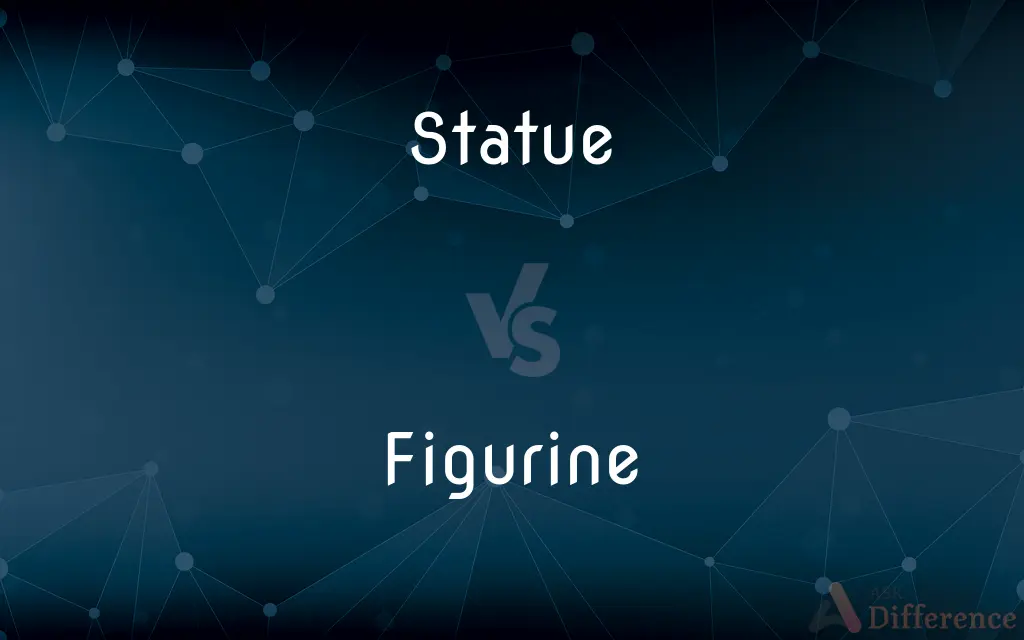Statue vs. Figurine — What's the Difference?
By Tayyaba Rehman & Maham Liaqat — Updated on April 2, 2024
A statue is a large, often life-sized or larger sculpture, while a figurine is a small, decorative representation, typically not meant for public monuments.

Difference Between Statue and Figurine
Table of Contents
ADVERTISEMENT
Key Differences
Statues are three-dimensional representations, usually made of materials like stone, metal, or wood, and are often life-sized or larger, depicting people, animals, or mythical figures. They serve various purposes, including commemoration, decoration, or worship, and are typically found in public spaces or as significant components of architectural structures. On the other hand, figurines are small, decorative objects, often made from materials like clay, porcelain, or plastic. They are primarily used for personal decoration, as collectibles, or in religious contexts. Figurines can represent a wide range of subjects, including humans, animals, and abstract concepts, but unlike statues, they are designed to be displayed in private spaces such as homes and offices.
While statues are often created as standalone pieces with a focus on realism and historical significance, figurines are usually part of a series or collection, emphasizing aesthetic appeal and personal value. Statues require a significant amount of material and labor to produce, reflecting their public and monumental nature. In contrast, figurines are mass-produced or handcrafted on a smaller scale, making them more accessible to a wider audience.
The distinction between a statue and a figurine also lies in their cultural and emotional significance. Statues often have a symbolic role, representing important historical events, religious deities, or notable figures, and are installed in places of honor. Figurines, while they can also hold personal or cultural significance, are generally seen as objects of affection, nostalgia, or aesthetic pleasure, rather than public commemoration.
Despite their differences, both statues and figurines share the purpose of capturing the essence of their subjects in a physical form, allowing people to connect with art, history, and culture in tangible ways. The choice between a statue and a figurine often depends on the intended use, the importance of the subject matter, and the context in which the object will be displayed.
Comparison Chart
Size
Life-sized or larger.
Small, easily held in hand.
ADVERTISEMENT
Material
Stone, metal, wood.
Clay, porcelain, plastic.
Purpose
Commemoration, decoration, worship.
Personal decoration, collectibles, religious objects.
Location
Public spaces, architectural structures.
Private spaces, homes, offices.
Production
Significant material and labor, often unique.
Mass-produced or handcrafted, more accessible.
Significance
Historical, symbolic, public commemoration.
Personal value, aesthetic appeal, nostalgia.
Compare with Definitions
Statue
Made for public viewing and commemoration.
Statues of historical leaders often adorn city squares.
Figurine
Represents a wide range of subjects.
Animal figurines are popular among children.
Statue
Serves as a cultural or historical landmark.
The statue in the park commemorates the city's founding.
Figurine
A small, decorative sculpture.
The porcelain figurine was displayed in a glass case.
Statue
Requires substantial materials and effort to create.
The marble statue was carved from a single block.
Figurine
Made from various materials, often delicate.
The clay figurine was intricately painted by hand.
Statue
Often installed outdoors or in significant buildings.
The bronze statue stands at the entrance of the museum.
Figurine
Easily placed in homes or offices for display.
A superhero figurine adorned his desk at work.
Statue
A large sculpture representing a figure or animal.
The Statue of Liberty is a symbol of freedom.
Figurine
Used for personal decoration or as collectibles.
She collects figurines from different countries.
Statue
A statue is a free-standing sculpture in which the realistic, full-length figures of persons or animals or non-representational forms are carved or cast in a durable material such as wood, metal or stone. Typical statues are life-sized or close to life-size; a sculpture that represents persons or animals in full figure but that is small enough to lift and carry is a statuette or figurine, whilst one more than twice life-size is a colossal statue.Statues have been produced in many cultures from prehistory to the present; the oldest-known statue dating to about 30,000 years ago.
Figurine
A figurine (a diminutive form of the word figure) or statuette is a small, three-dimensional sculpture that represents a human, deity or animal, or, in practice, a pair or small group of them. Figurines have been made in many media, with clay, metal, wood, glass, and today plastic or resin the most significant.
Statue
A carved or cast figure of a person or animal, especially one that is life-size or larger.
Figurine
A statuette, especially one of a human form.
Statue
A three-dimensional form or likeness sculpted, modeled, carved, or cast in material such as stone, clay, wood, or bronze.
Figurine
A small molded or sculptured figure; a statuette.
Statue
A three-dimensional work of art, usually representing a person or animal, usually created by sculpting, carving, molding, or casting.
Figurine
A small carved or molded figure; a statuette.
Statue
(dated) A portrait.
Figurine
A very small figure, whether human or of an animal; especially, one in terra cotta or the like; - distinguished from statuette, which is applied to small figures in bronze, marble, etc.
Statue
(transitive) To form a statue of; to make into a statue.
Figurine
A small carved or molded figure
Statue
The likeness of a living being sculptured or modeled in some solid substance, as marble, bronze, or wax; an image; as, a statue of Hercules, or of a lion.
I will raise her statue in pure gold.
Statue
A portrait.
Statue
To place, as a statue; to form a statue of; to make into a statue.
Statue
A sculpture representing a human or animal
Common Curiosities
Are statues always installed in public places?
Typically, yes, statues are intended for public viewing and are placed in spaces like parks, squares, or outside buildings.
What is a figurine?
A figurine is a small, decorative sculpture typically made of clay, porcelain, or plastic, used for personal decoration or as part of a collection.
How do statues and figurines differ in size?
Statues are usually life-sized or larger, while figurines are small enough to be held in the hand.
Can figurines have historical significance like statues?
While figurines can hold personal or cultural significance, they are generally not used for public commemoration like statues.
How are figurines made?
Figurines can be mass-produced using molds or handcrafted with fine details, depending on the material and the intended finish.
Why are statues important in history?
Statues serve as physical reminders of historical events, figures, or cultural significance, contributing to a society's collective memory.
Do figurines serve a practical purpose?
Beyond decoration or collecting, figurines can have religious significance or serve as memorabilia, but they are generally not meant for practical use.
Can a figurine ever be considered a statue?
Typically, the term "figurine" is reserved for smaller, decorative items, but a small statue could be referred to as a figurine based on its context and use.
How does one care for statues and figurines?
Care depends on the material, with statues often requiring professional maintenance for outdoor elements, and figurines needing gentle cleaning to avoid damage.
What role do figurines play in popular culture?
Figurines are popular collectibles, representing characters from movies, comics, and video games, and serve as a form of fandom expression.
What is a statue?
A statue is a large sculpture depicting a figure or animal, often made of stone, metal, or wood, and placed in public for commemoration or decoration.
What materials are used to make statues?
Statues are made from durable materials like stone, metal, and wood to withstand outdoor conditions.
What is the most famous statue in the world?
While subjective, the Statue of Liberty in New York is among the most iconic and widely recognized statues globally.
How do people choose between displaying a statue or figurine?
The choice usually depends on the space available, the significance of the piece, and the personal or aesthetic value it adds to the environment.
Are there modern statues?
Yes, modern statues continue to be created and installed to commemorate contemporary figures, events, or artistic expressions.
Share Your Discovery

Previous Comparison
Sausage vs. Kielbasa
Next Comparison
Snuggly vs. SnuglyAuthor Spotlight
Written by
Tayyaba RehmanTayyaba Rehman is a distinguished writer, currently serving as a primary contributor to askdifference.com. As a researcher in semantics and etymology, Tayyaba's passion for the complexity of languages and their distinctions has found a perfect home on the platform. Tayyaba delves into the intricacies of language, distinguishing between commonly confused words and phrases, thereby providing clarity for readers worldwide.
Co-written by
Maham Liaqat














































